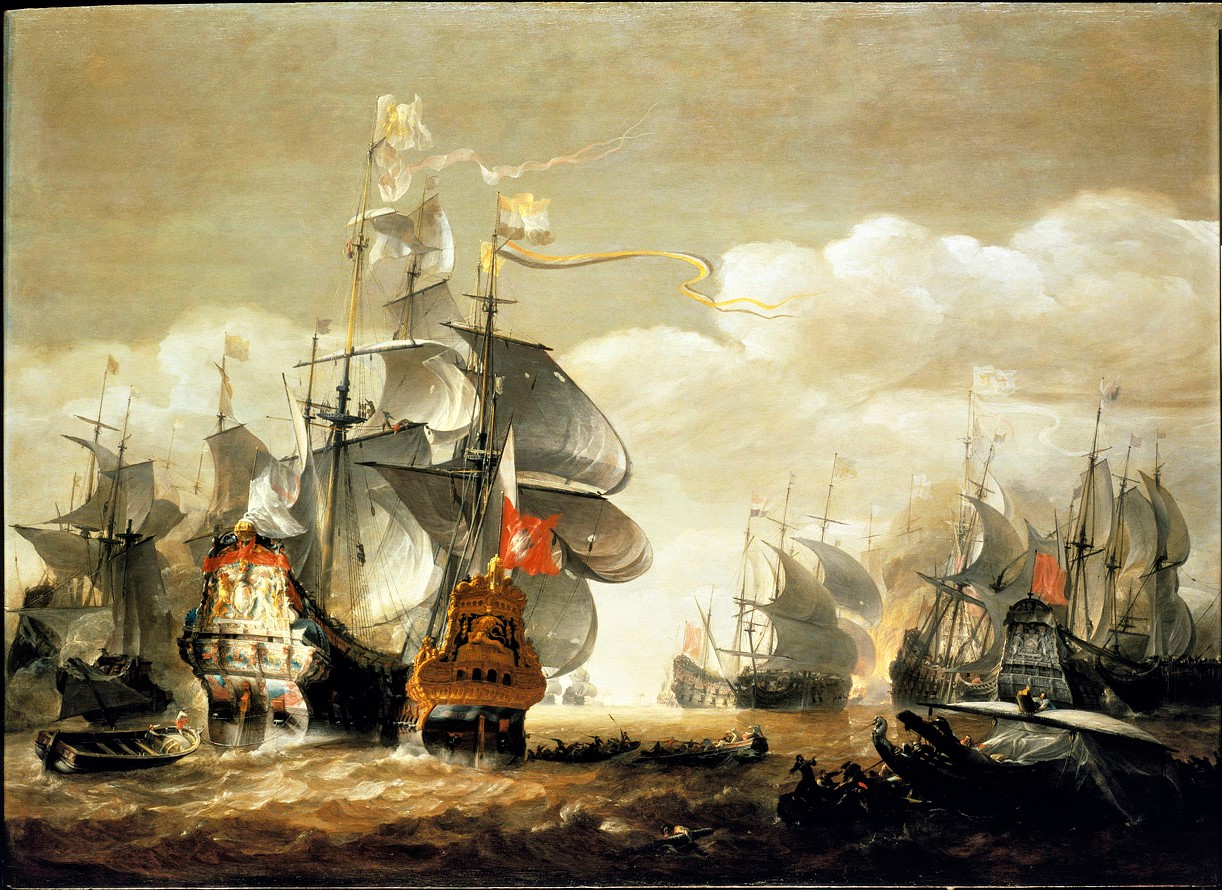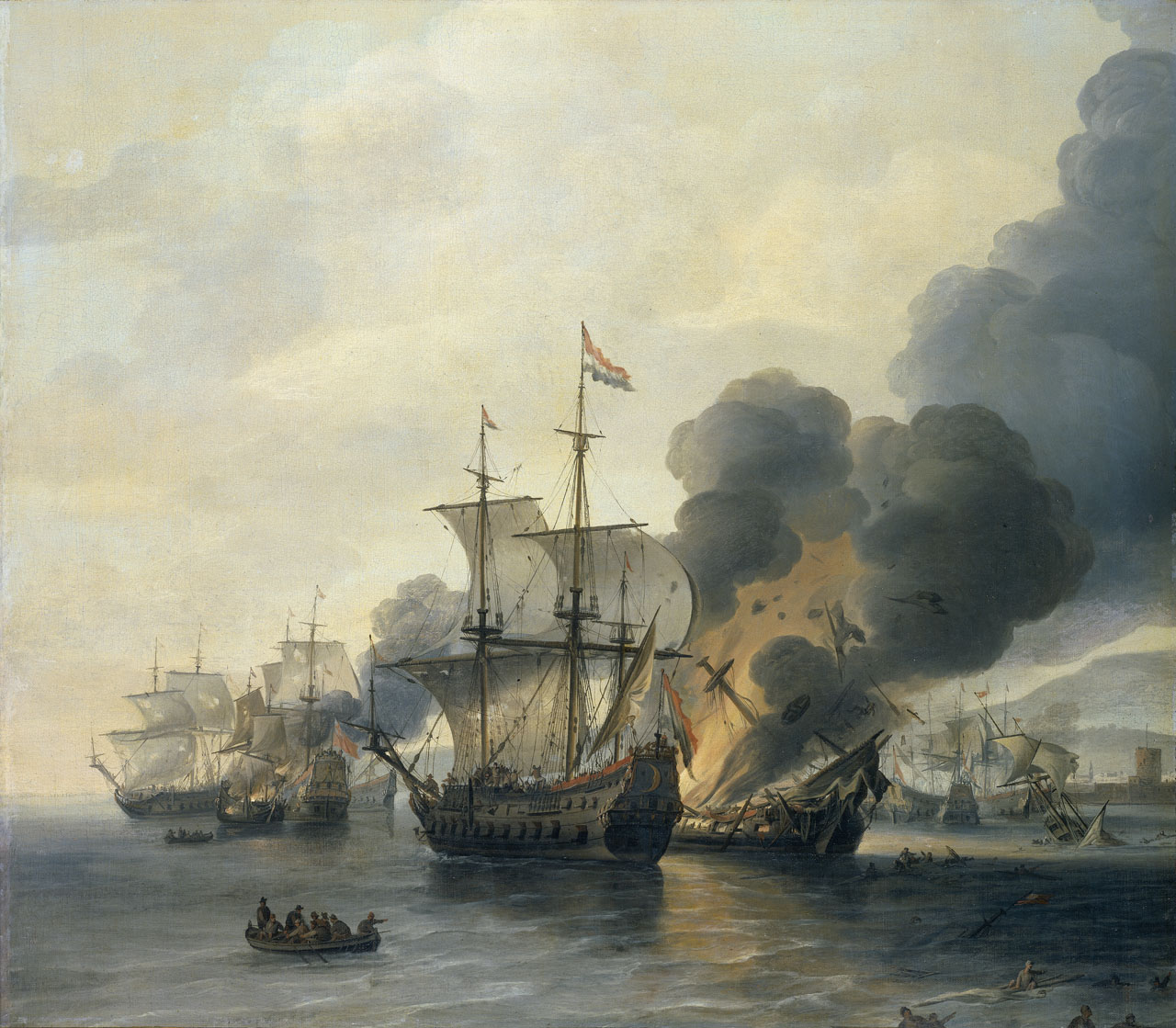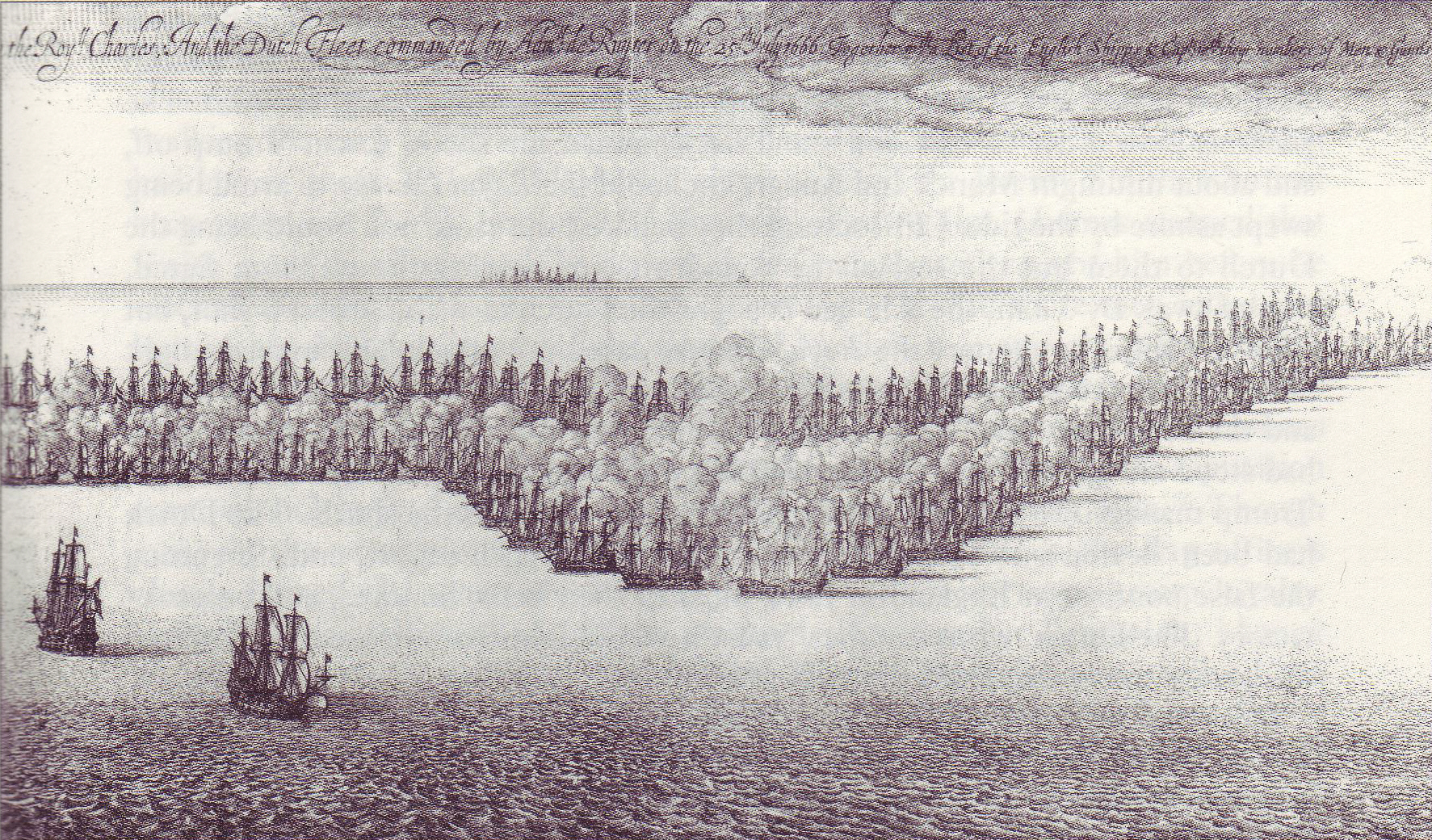|
Tjerk Hiddes De Vries
Tjerk Hiddes de Vries (Sexbierum, 6 August 1622 - Flushing, Netherlands, Flushing, 6 August 1666) was a hero, naval hero and Netherlands, Dutch admiral from the seventeenth century. The French, who could not pronounce his name, called him Kiërkides. His name was also given as ''Tsjerk'', ''Tierck'' or ''Tjerck''. Early life and childhood Tierck was born in 1622 in the province of Friesland (Frisia), in the village of Sexbierum as the son of a poor farmer called Hidde Siurds and his wife Swab Tjeirckdochter. At the age of twelve, he went to sea. In 1648 he married Nannetje Atses; the couple settled in Harlingen, Netherlands, Harlingen, Frisia's main port. In 1654 he had attained the rank of master. Naval career During the Northern Wars Tjerk was appointed captain of a troop transport, the ''Judith'', that in 1658 was part of Lieutenant-Admiral Jacob van Wassenaer Obdam's expeditionary fleet against Sweden to relief Copenhagen. In the Battle of the Sound the sea soldiers of ... [...More Info...] [...Related Items...] OR: [Wikipedia] [Google] [Baidu] |
Battle Of Lowestoft
The Battle of Lowestoft took place on during the Second Anglo-Dutch War. A fleet of more than a hundred ships of the United Provinces commanded by Lieutenant-Admiral Jacob van Wassenaer, Lord Obdam attacked an English fleet of equal size commanded by James, Duke of York forty miles east of the port of Lowestoft in Suffolk. Although it was a substantial English victory, the escape of the bulk of the Dutch fleet deprived England of the chance of ending the war quickly with a single decisive victory. As a result, the Dutch were able to make good their losses by building new and better-armed ships and improving their organisation and discipline. Their Dutch fleets would not be so badly organised or ill-disciplined in the remaining battles of this war and, in Obdam's replacement, Michiel de Ruyter, the Dutch had gained a superb tactician and leader for the remainder of the war. Background The Second Anglo-Dutch War resulted from long-standing commercial tensions between England ... [...More Info...] [...Related Items...] OR: [Wikipedia] [Google] [Baidu] |
17th-century Dutch Military Personnel
The 17th century lasted from January 1, 1601 ( MDCI), to December 31, 1700 ( MDCC). It falls into the early modern period of Europe and in that continent (whose impact on the world was increasing) was characterized by the Baroque cultural movement, the latter part of the Spanish Golden Age, the Dutch Golden Age, the French ''Grand Siècle'' dominated by Louis XIV, the Scientific Revolution, the world's first public company and megacorporation known as the Dutch East India Company, and according to some historians, the General Crisis. From the mid-17th century, European politics were increasingly dominated by the Kingdom of France of Louis XIV, where royal power was solidified domestically in the civil war of the Fronde. The semi-feudal territorial French nobility was weakened and subjugated to the power of an absolute monarchy through the reinvention of the Palace of Versailles from a hunting lodge to a gilded prison, in which a greatly expanded royal court could be more easily ... [...More Info...] [...Related Items...] OR: [Wikipedia] [Google] [Baidu] |
1666 Deaths
This is the first year to be designated as an ''Annus mirabilis'', in John Dryden's 1667 poem so titled, celebrating England's failure to be beaten either by the Dutch or by fire. It is the only year to contain each Roman numeral once in descending order (1000(M)+500(D)+100(C)+50(L)+10(X)+5(V)+1(I) = 1666). Events January–March * January 17 – The Chair of Saint Peter (''Cathedra Petri'', designed by Bernini) is set above the altar in St. Peter's Basilica in Rome. * February 1 – The joint English and Scottish royal court returns to London, as the Great Plague of London subsides. * March 11 – The tower of St. Peter's Church in Riga, collapses, burying eight people in the rubble. April–June * April 20 – In colonial British North America, " Articles of Peace and Amity" are signed between the governments of the Province of Maryland and 12 Eastern Algonquian tribes — the Piscataways, Anacostancks, Doegs, Mattawomans, Portob ... [...More Info...] [...Related Items...] OR: [Wikipedia] [Google] [Baidu] |
1622 Births
Sixteen or 16 may refer to: *16 (number), the natural number following 15 and preceding 17 *one of the years 16 BC, AD 16, 1916, 2016 Films * '' Pathinaaru'' or ''Sixteen'', a 2010 Tamil film * ''Sixteen'' (1943 film), a 1943 Argentine film directed by Carlos Hugo Christensen * ''Sixteen'' (2013 Indian film), a 2013 Hindi film * ''Sixteen'' (2013 British film), a 2013 British film by director Rob Brown Music *The Sixteen, an English choir * 16 (band), a sludge metal band * Sixteen (Polish band), a Polish band Albums * ''16'' (Robin album), a 2014 album by Robin * 16 (Madhouse album), a 1987 album by Madhouse * ''Sixteen'' (album), a 1983 album by Stacy Lattisaw *''Sixteen'' , a 2005 album by Shook Ones * ''16'', a 2020 album by Wejdene Songs * "16" (Sneaky Sound System song), 2009 * "Sixteen" (Thomas Rhett song), 2017 * "Sixteen" (Ellie Goulding song), 2019 *"16", by Craig David from ''Following My Intuition'', 2016 *"16", by Green Day from ''39/Smooth'', 1990 *"16", ... [...More Info...] [...Related Items...] OR: [Wikipedia] [Google] [Baidu] |
Royal Netherlands Navy
The Royal Netherlands Navy ( nl, Koninklijke Marine, links=no) is the naval force of the Kingdom of the Netherlands. During the 17th century, the navy of the Dutch Republic (1581–1795) was one of the most powerful naval forces in the world and played an active role in the Anglo-Dutch Wars, the Franco-Dutch War, and wars against Spain and several other European powers. The Batavian Navy of the later Batavian Republic (1795–1806) and Kingdom of Holland (1806–1810) played an active role in the Napoleonic Wars, though mostly dominated by French interests. After the establishment of the modern Kingdom of the Netherlands, it served an important role in protecting Dutch colonial rule, especially in Southeast Asia, and would play a minor role in World War II, especially against the Imperial Japanese Navy. Since World War II, the Royal Netherlands Navy has taken part in expeditionary peacekeeping operations. Bases The main naval base is in Den Helder, North Holland. Secondary na ... [...More Info...] [...Related Items...] OR: [Wikipedia] [Google] [Baidu] |
Folk Hero
A folk hero or national hero is a type of hero – real, fictional or mythological – with their name, personality and deeds embedded in the popular consciousness of a people, mentioned frequently in folk songs, folk tales and other folklore; and with modern trope status in literature, art and films. Overview Although some folk heroes are historical public figures, many are not. The lives of folk heroes are generally fictional, their characteristics and deeds often exaggerated to mythic proportions. The folk hero often begins life as a normal person, but is transformed into someone extraordinary by significant life events, often in response to social injustice, and sometimes in response to natural disasters. One major category of folk hero is the defender of the common people against the oppression or corruption of the established power structure. Members of this category of folk hero often, but not necessarily, live outside the law in some way. See also * List of folk ... [...More Info...] [...Related Items...] OR: [Wikipedia] [Google] [Baidu] |
Hans Willem Van Aylva
Hans Willem van Aylva (c. 1633, Holwerd – 21 February 1691, near Leuven) was a Dutch soldier and lieutenant general. Raid on the Medway and Franco-Dutch War In 1667 he participated in the Dutch Raid on Medway, as commander of the Frisian squadron. He was appointed a major general in 1668 and promoted to lieutenant general four years later.In 1672, at the start of the Franco-Dutch War after Prince William III's appointment as captain general, he was again appointed lieutenant general of infantry and charged with the defence of Friesland. Aylva waged a kind of guerrilla war in the surroundings of Heerenveen; with a small force and his Frisian militias, he had hastily put Friesland in a state of defence by raising earthen entrenchments on the south-east side, forming a line from Kuinre along Heerenveen to Groningen. In July 1672, he led an unsuccessful attack with 1200 soldiers and civilians on Kuinre, where the troops of the Bishop of Munster had gathered much booty. Already 200 ... [...More Info...] [...Related Items...] OR: [Wikipedia] [Google] [Baidu] |
Cornelis Tromp
Cornelis Maartenszoon Tromp, ''Count of Sølvesborg'' (3 September 1629 – 29 May 1691) was a Dutch naval officer who served as lieutenant-admiral general in the Dutch Navy, and briefly as a general admiral in the Royal Danish Navy. Tromp fought in the Anglo-Dutch Wars and the Scanian War. His father was Lieutenant Admiral Maarten Tromp. Biography Early life Cornelis Maartenszoon Tromp was born on 9 September 1629, in Rotterdam, in the historically dominant county of Holland. He was the second son of Maarten Tromp and Dina Cornelisdochter de Haas. His name Maartenszoon, sometimes abbreviated to Maartensz, is a patronymic. He had two full brothers, Harper and Johan.Tromp, Cornelis in ''Nieuw Nederlandsch biografisch woordenboek. Deel 5''. Retrieved 5 May 2009. In 1633, when he was only four ye ... [...More Info...] [...Related Items...] OR: [Wikipedia] [Google] [Baidu] |
Rupert Of The Rhine
Prince Rupert of the Rhine, Duke of Cumberland, (17 December 1619 (O.S.) / 27 December (N.S.) – 29 November 1682 (O.S.)) was an English army officer, admiral, scientist and colonial governor. He first came to prominence as a Royalist cavalry commander during the English Civil War.). Rupert was the third son of the German Prince Frederick V of the Palatinate and Elizabeth, eldest daughter of King James VI and I of Scotland and England. Prince Rupert had a varied career. He was a soldier as a child, fighting alongside Dutch forces against Habsburg Spain during the Eighty Years' War (1568–1648), and against the Holy Roman Emperor in Germany during the Thirty Years' War (1618–1648). Aged 23, he was appointed commander of the Royalist cavalry during the English Civil War, becoming the archetypal "Cavalier" of the war and ultimately the senior Royalist general. He surrendered after the fall of Bristol and was banished from England. He served under King Louis XIV of France aga ... [...More Info...] [...Related Items...] OR: [Wikipedia] [Google] [Baidu] |
Johan Evertsen
Johan Evertsen (1 February 1600 – 5 August 1666) was a Dutch admiral who was born in the 17th century. Early life Like his five brothers, Evertsen started his military career as a lieutenant after the death of his father, "Captain Jan". He quickly moved through the ranks, fighting battles with corsairs and protecting Dutch ships from other privateers. Evertsen was eventually promoted to the rank of admiral during the Anglo-Dutch Wars. Despite Evertsen's successes and influence in the Dutch Navy, his abilities were questioned due to rumours that he was a coward. Career Evertsen was born in Vlissingen. He was the eldest (surviving) son of Johan Evertsen, also known as Captain Jan who died in 1617 fighting near La Rochelle against a French corsair. In gratitude for the services he rendered, all five sons of Captain Jan were named lieutenants by the Admiralty of Zeeland. At age 18, he was made captain of a ship. He fought near La Rochelle in 1625 under Willem de Zoete, and in ... [...More Info...] [...Related Items...] OR: [Wikipedia] [Google] [Baidu] |
St James's Day Battle
St James' Day Battle (also known as St James' Day Fight, the Battle of the North Foreland and the Battle of Orfordness) took place on 25 July 1666 — St James' day in the Julian calendar then in use in England (4 August 1666 in the Gregorian calendar), during the Second Anglo-Dutch War. It was fought between fleets of England, commanded jointly by Prince Rupert of the Rhine and George Monck, 1st Duke of Albemarle, and the United Provinces commanded by Lieutenant-Admiral Michiel de Ruyter. In the Netherlands, the battle is known as the Two Days' Battle. Background This attack followed on the heels of the Four Days' Battle of 1–4 June 1666 which is normally considered a Dutch victory. Battle First day In the early morning of 25 July, the Dutch fleet of 88 ships discovered the English fleet of 89 ships near North Foreland, sailing to the north. De Ruyter gave orders for a chase and the Dutch fleet pursued the English from the southeast in a leeward position, as the wind b ... [...More Info...] [...Related Items...] OR: [Wikipedia] [Google] [Baidu] |




%2C_Gesneuveld_in_de_zeeslag_tegen_de_Engelsen.jpg)
